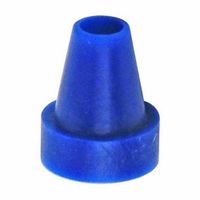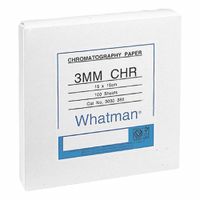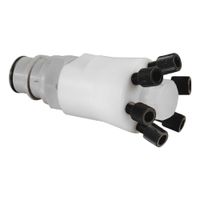Call +(254) 703 030 000 / 751 483 999 / 721 704 777
- Home
- Lab Supplies
- Chromatography
.....Read More
Frequently Asked Questions
What is chromatography and how does it work?
Chromatography is a laboratory technique used for the separation of mixtures. The mixture is dissolved in a fluid called the mobile phase, which carries it through a structure holding another material called the stationary phase. The various components of the mixture travel at different speeds, causing them to separate. This separation is based on the differential partitioning between the mobile and stationary phases.
There are several types of chromatography, each utilizing different stationary and mobile phases and separation principles. Common types include: * Liquid Chromatography (LC): Uses a liquid mobile phase and a solid or liquid stationary phase. High-Performance Liquid Chromatography (HPLC) is a widely used form of LC.
* Gas Chromatography (GC): Employs a gaseous mobile phase and a liquid or solid stationary phase.
* Paper Chromatography: Uses a strip of paper as the stationary phase and a solvent as the mobile phase.
* Thin-Layer Chromatography (TLC): Similar to paper chromatography but uses a thin layer of adsorbent material on a flat, inert substrate.The core principle involves the differing affinities of the mixture's components for the stationary versus the mobile phase. Components that have a stronger interaction with the stationary phase will move more slowly, while those with a weaker interaction will move faster. This differential movement leads to their separation into distinct bands or peaks, which can then be detected, identified, and quantified. Chromatography is a versatile technique used in various fields, including chemistry, biochemistry, environmental science, and pharmaceuticals, for analysis, purification, and quality control.
What are the different types of chromatography?
Chromatography is a laboratory technique for the separation of a mixture. The mixture is dissolved in a fluid called the mobile phase, which carries it through a structure holding another material called the stationary phase. The various constituents of the mixture travel at different speeds, causing them to separate.
There are several types of chromatography, each suited for different applications: * **Liquid Chromatography (LC):** This is a widely used type where the mobile phase is a liquid. It includes techniques like High-Performance Liquid Chromatography (HPLC) which offers high resolution and speed, and size-exclusion chromatography for separating molecules based on their size.
* **Gas Chromatography (GC):** In GC, the mobile phase is an inert gas (e.g., helium or nitrogen) and the stationary phase is a liquid or solid on a solid support. It's ideal for volatile and thermally stable compounds.
* **Thin-Layer Chromatography (TLC):** A simple and inexpensive technique where the stationary phase is a thin layer of adsorbent material (like silica gel) coated on a flat, inert substrate. The mobile phase moves up the plate by capillary action.
* **Paper Chromatography:** Similar to TLC, but the stationary phase is a strip of filter paper. It's often used for separating inks or plant pigments.
* **Ion-Exchange Chromatography:** This technique separates ions and polar molecules based on their affinity to an ion exchanger. The stationary phase has charged functional groups that interact with charged analytes.
* **Affinity Chromatography:** This highly specific method separates biomolecules based on a specific binding interaction between the analyte and a ligand immobilized on the stationary phase.
How is chromatography used in real-world applications?
Chromatography is a powerful analytical technique used to separate, identify, and quantify components in a mixture. In real-world applications, it's widely used in various fields:
In pharmaceuticals, chromatography is crucial for drug discovery, development, and quality control. It's used to purify drug compounds, analyze their purity, and ensure consistency in production. For example, high-performance liquid chromatography (HPLC) is standard for monitoring drug stability and dissolution rates.
In environmental science, chromatography helps detect pollutants in air, water, and soil. Gas chromatography-mass spectrometry (GC-MS) can identify trace amounts of pesticides, herbicides, and volatile organic compounds, aiding in environmental monitoring and risk assessment.
In food and beverage industries, chromatography ensures product quality and safety. It's used to analyze nutritional content, detect contaminants like mycotoxins or heavy metals, and authenticate ingredients. For instance, it can determine sugar profiles in juices or identify adulteration in olive oil.
Forensic science utilizes chromatography to analyze samples from crime scenes, such as drugs, explosives, or accelerants in arson investigations. This helps identify substances and link suspects to criminal activities.
In biotechnology, chromatography is essential for purifying proteins, enzymes, and nucleic acids for research and therapeutic purposes, such as in vaccine production or gene therapy.
What are the main components of a chromatography system?
A chromatography system typically consists of several main components working in conjunction to separate, identify, and quantify components in a mixture. The solvent delivery system, often including pumps, provides a continuous flow of the mobile phase through the system. The injector introduces the sample into the mobile phase, which then carries it to the column. The column is the heart of the separation, containing the stationary phase that interacts with the sample components, leading to their separation. Following the column, a detector senses the separated components as they elute, generating a signal proportional to their concentration. Finally, a data acquisition system records and processes the detector signals, presenting them as a chromatogram for analysis. Additional components can include an autosampler for automated sample injection, a column oven for temperature control, and various valves and tubing to direct the flow.
How do you choose the right chromatography column for your analysis?
When choosing the right chromatography column for your analysis, several factors need to be considered to ensure optimal separation and accurate results.
First, consider the properties of your analytes, such as their polarity, molecular weight, and functional groups. This will help you determine the appropriate stationary phase (e.g., C18, C8, silica, ion-exchange) that will interact favorably with your compounds.
Second, think about the complexity of your sample matrix and the presence of any interfering substances. A more complex matrix might require a column with higher selectivity and efficiency to achieve good resolution.
Third, consider the type of chromatography technique you are performing (e.g., HPLC, GC, IC). Each technique has specific column requirements, including dimensions (length and internal diameter) and particle size. Smaller particle sizes generally offer higher efficiency but may result in higher back pressure.
Fourth, consider the detection method you will be using. Some detectors are more sensitive to certain mobile phase components or column bleed, which might influence your choice of stationary phase or column material.
Finally, think about the desired resolution, analysis time, and cost. A balance between these factors is often necessary to select the most suitable column for your specific application. Consulting column manufacturers' guidelines and literature for similar applications can also be very helpful in making an informed decision.
What are the advantages and disadvantages of ion-exchange chromatography?
Ion-exchange chromatography (IEC) is a powerful separation technique used to separate molecules based on their net charge.
Advantages of IEC:
High Resolution: IEC offers excellent resolution, allowing for the separation of molecules with very small differences in charge. This makes it ideal for separating closely related proteins, nucleic acids, and other charged biomolecules.
High Loading Capacity: Ion-exchange columns can typically bind a large amount of sample, making it suitable for preparative purification where significant quantities of a target molecule are needed.
Versatility: IEC can be used for a wide range of molecules, from small ions to large proteins and even viruses, by simply adjusting the pH and salt concentration of the mobile phase and selecting the appropriate ion-exchange resin.
Reusability: Ion-exchange columns can often be regenerated and reused multiple times, contributing to cost-effectiveness.
Scalability: The technique is easily scalable from analytical to preparative scales, making it valuable for both research and industrial applications.
Disadvantages of IEC:
Sensitivity to pH and Ionic Strength: The effectiveness of IEC is highly dependent on the pH and ionic strength of the buffer, which can make method development challenging. Small variations can significantly impact separation.
Sample Preparation Requirements: Samples often need to be desalted or extensively dialyzed before loading onto an IEC column to ensure optimal binding and separation.
Potential for Denaturation: In some cases, the interaction between the charged molecules and the stationary phase can be strong enough to cause denaturation of sensitive biomolecules, leading to loss of activity.
Column Fouling: Proteins and other biomolecules can sometimes irreversibly bind to the column or precipitate, leading to column fouling and reduced column life.
Limited Applicability for Uncharged Molecules: IEC is not suitable for separating uncharged molecules, as it relies on electrostatic interactions.
How do you maintain and troubleshoot chromatography equipment?
Maintaining chromatography equipment involves regular cleaning of components, checking for leaks, and calibrating detectors. Troubleshooting often involves identifying the source of peak issues (e.g., tailing, fronting, splitting), which can be related to column degradation, mobile phase problems, or injector/detector issues. Regular maintenance logs and adherence to manufacturer guidelines are crucial for optimal performance and longevity of the equipment.
What role do chromatography accessories play in the analysis process?
Chromatography accessories are integral to the efficiency, accuracy, and reproducibility of the analytical process. They encompass a wide array of components that support the main chromatographic system, whether it's gas chromatography (GC), liquid chromatography (LC), or other variations.
For instance, in sample preparation, accessories like syringes, vials, and filters are crucial. Syringes are used for precise sample injection, while vials safely contain samples before analysis. Filters remove particulate matter that could damage the column or interfere with separation.
Within the chromatography system itself, various accessories ensure optimal performance. Columns, though often considered a core component, are supported by accessories like column heaters/coolers for temperature control, and guard columns that protect the main analytical column from contaminants, extending its lifespan. Fittings, tubing, and connectors ensure leak-free connections and smooth flow of the mobile phase.
Detectors, which identify and quantify separated components, often rely on accessories such as lamps (e.g., UV lamps for UV-Vis detectors), flow cells, and specialized nebulizers for techniques like mass spectrometry. Data acquisition systems, which record and process the detector's signal, also fall under this umbrella, providing the interface for data interpretation.
Finally, post-analysis accessories like fraction collectors are used in preparative chromatography to isolate separated compounds. Overall, chromatography accessories are indispensable for maintaining system integrity, improving separation efficiency, enhancing detection sensitivity, and ultimately ensuring reliable and accurate analytical results.
How does chromatography paper differ from other types of chromatography media?
Chromatography paper differs from other chromatography media primarily in its stationary phase and how the separation occurs. In paper chromatography, the stationary phase is a sheet of high-quality cellulose paper. This contrasts with other common types like thin-layer chromatography (TLC), which uses a thin layer of adsorbent material (e.g., silica gel, alumina) coated on a glass or plastic plate, or column chromatography, where the stationary phase is packed into a column (e.g., silica, ion-exchange resins).
The key difference lies in the mechanism of separation. In paper chromatography, the separation is mainly due to partition, where the components of the mixture distribute themselves between the stationary aqueous phase (adsorbed onto the cellulose fibers) and the mobile organic solvent phase. The differing solubilities of the components in these two phases lead to their separation.
In contrast, TLC often relies more on adsorption, where components adhere to the surface of the stationary phase to varying degrees. Column chromatography can utilize various mechanisms including adsorption, partition, ion exchange, or size exclusion, depending on the type of stationary phase used.
Additionally, paper chromatography is generally simpler, less expensive, and requires minimal equipment, making it suitable for qualitative analysis and educational purposes. TLC offers better resolution and faster separations for more complex mixtures. Column chromatography provides the highest resolution and is often used for preparative separations.
What are common challenges faced in chromatography and how can they be overcome?
Common challenges in chromatography include poor peak resolution, tailing or fronting peaks, baseline noise, and inconsistent retention times. These issues often stem from problems with the column, mobile phase, sample preparation, or instrument parameters.
To overcome these challenges, ensure proper column selection and maintenance; a worn or contaminated column can significantly impact results. Optimize the mobile phase composition, pH, and flow rate to achieve ideal separation. Thorough sample preparation, including filtration and appropriate dilution, prevents column fouling and extraneous peaks. Regular instrument calibration and maintenance, such as checking for leaks and cleaning detectors, are crucial for reproducible and accurate data. Additionally, understanding the chemistry of your analytes and stationary phase can help in troubleshooting and method development, leading to robust and reliable chromatographic methods.





